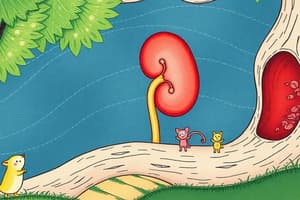Podcast
Questions and Answers
What is the renal threshold for arterial plasma glucose levels?
What is the renal threshold for arterial plasma glucose levels?
- 240 mg/dL
- 220 mg/dL
- 200 mg/dL (correct)
- 180 mg/dL
What effect does alcohol have on antidiuretic hormone (ADH)?
What effect does alcohol have on antidiuretic hormone (ADH)?
- Inhibits its action (correct)
- Has no effect
- Enhances its action
- Increases its production
Which hormone primarily increases sodium reabsorption at the distal convoluted tubule (DCT)?
Which hormone primarily increases sodium reabsorption at the distal convoluted tubule (DCT)?
- Renin
- Antidiuretic hormone (ADH)
- Aldosterone (correct)
- Atrial natriuretic peptide (ANP)
What is a direct effect of angiotensin II in the renin-angiotensin-aldosterone system?
What is a direct effect of angiotensin II in the renin-angiotensin-aldosterone system?
What characterizes the water reabsorption in the descending loop of Henle?
What characterizes the water reabsorption in the descending loop of Henle?
What is the primary action of atrial natriuretic peptide (ANP)?
What is the primary action of atrial natriuretic peptide (ANP)?
What is the primary force behind the reabsorption of sodium in the proximal tubule?
What is the primary force behind the reabsorption of sodium in the proximal tubule?
Which substance is mainly reabsorbed in the first half of the proximal tubule?
Which substance is mainly reabsorbed in the first half of the proximal tubule?
During which phase is sodium reabsorbed primarily with chloride ions in the proximal tubule?
During which phase is sodium reabsorbed primarily with chloride ions in the proximal tubule?
What is the renal threshold for glucose in terms of plasma level?
What is the renal threshold for glucose in terms of plasma level?
Which part of the nephron is primarily responsible for facultative water reabsorption?
Which part of the nephron is primarily responsible for facultative water reabsorption?
What is the main method of glucose reabsorption in the early portion of the proximal tubule?
What is the main method of glucose reabsorption in the early portion of the proximal tubule?
Which substance is NOT reabsorbed in the proximal convoluted tubule?
Which substance is NOT reabsorbed in the proximal convoluted tubule?
Flashcards are hidden until you start studying
Study Notes
Tubular Reabsorption
- The proximal convoluted tubule (PCT) reabsorbs a wide range of substances including K+, Cl-, Na+, Mg2+, bicarbonate, phosphate, amino acids, glucose, water.
- The descending loop of Henle primarily reabsorbs water and urea.
- The ascending loop of Henle reabsorbs K+, Cl-, Na+, and urea.
- The distal convoluted tubule (DCT) reabsorbs K+, Cl-, Na+, H+, and water.
- The collecting duct reabsorbs K+, Cl-, Na+, water, and urea.
- Glucose, amino acids, sodium, potassium, calcium, bicarbonate, chloride, phosphate, uric acid, and water are reabsorbed from the PCT.
- Sodium, chloride, and water are reabsorbed from the loop of Henle.
- Sodium, chloride, bicarbonate, and water are reabsorbed from the DCT.
- Sodium reabsorption in the proximal tubule is driven by the sodium-potassium ATPase, a primary active transport system that pumps sodium out of the cell and potassium into the cell.
- Sodium reabsorption in the first half of the PCT is coupled to the transport of glucose, amino acids, and other solutes.
- In the second half of the PCT, sodium is reabsorbed mainly with chloride ions.
- Both the PCT and the descending loop of Henle are highly permeable to water, leading to obligatory water reabsorption, which is driven by sodium reabsorption.
- The DCT, ascending loop of Henle, and collecting duct have low water permeability, making water reabsorption facultative, which is dependent on Antidiuretic Hormone (ADH).
- Glucose reabsorption occurs primarily in the PCT and is completely reabsorbed under normal conditions.
- Glucose is reabsorbed along with Na+, via secondary active transport, meaning it relies on the energy of Na+ gradient created by the sodium-potassium ATPase.
- The renal threshold for glucose is the plasma level at which glucose first appears in the urine.
- The actual renal threshold is around 200 mg/dL arterial plasma.
- Potassium reabsorption and secretion are also crucial for maintaining electrolyte balance.
Factors affecting kidney function
- Antidiuretic Hormone (ADH): ADH increases water permeability in the DCT and collecting duct, leading to increased water reabsorption and less urine production. Alcohol and caffeine inhibit ADH action.
- Aldosterone: Aldosterone increases sodium reabsorption and potassium secretion in the DCT.
- Atrial Natriuretic Peptide (ANP): ANP decreases sodium reabsorption and increases urination.
- Renin-Angiotensin-Aldosterone System (RAAS):
- Renin converts angiotensinogen to angiotensin I.
- Angiotensin I is converted to angiotensin II in the lungs.
- Angiotensin II has several effects:
- Increases thirst
- Increases ADH release
- Increases aldosterone production
- Causes vasoconstriction
- The RAAS is essential for regulating blood pressure.
Studying That Suits You
Use AI to generate personalized quizzes and flashcards to suit your learning preferences.



